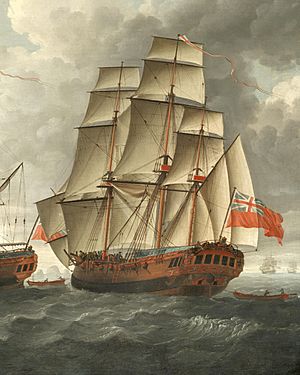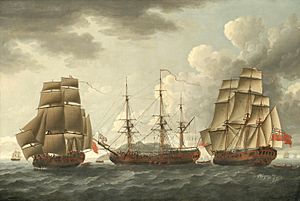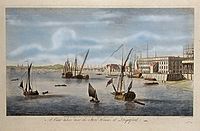HMS Trial (1744) facts for kids

HMS Tryall
|
|
Quick facts for kids History |
|
|---|---|
| Name | HMS Trial |
| Ordered | 18 August 1743 |
| Builder | Deptford Dockyard |
| Laid down | 15 September 1743 |
| Launched | 17 July 1744 |
| Completed | 28 August 1744 at Deptford Dockyard |
| Commissioned | July 1744 |
| Fate | Broken up at Woolwich on 3 January 1776 |
| General characteristics | |
| Class and type | Hind-class sloop |
| Tons burthen | 272 46⁄94 (bm) |
| Length |
|
| Beam | 26 ft 1.75 in (8.0 m) |
| Depth of hold | 12 ft 0.75 in (3.7 m) |
| Sail plan | Snow brig |
| Armament | 10 × 6-pounder guns, later increased to 14 x 6-pounder guns |
HMS Trial (also spelled Tryall) was a small but important ship of the Royal Navy. She was a type of ship called a sloop, which means she was a fast, two-masted ship used for patrols and scouting. Trial was built in England at Deptford Dockyard on the Thames River. She was launched on July 17, 1744.
Trial was special because she and her sister ship, Jamaica, were the only sloops built in the Royal Dockyards for many years. She served the Navy for over 28 years. In 1772, she was taken out of service and later taken apart in 1776.
Contents
The order to build Trial was given on August 18, 1743. Work on the ship began the very next month. She was designed to be a "snow brig," a type of ship with two masts and a special sail.
Trial's main deck was about 27.9 meters (91 feet 6 inches) long. Her widest part, called the beam, was about 7.9 meters (26 feet 1.75 inches). Building her cost about £5,050, which was a lot of money back then!
Over the years, Trial needed some repairs. Smaller fixes happened in 1754 and 1757. A much bigger repair job took ten months in 1767–68.
Ship's Weapons and Crew
When first built, Trial had ten cannons that fired 6-pound cannonballs. She also had 14 smaller guns called swivel guns. Her crew was made up of 110 sailors. In 1748, the Navy decided to make her stronger. They added four more 6-pound cannons, bringing the total to 14. They also added 15 more sailors to her crew.
Serving in the War of the Austrian Succession

Trial officially joined the Navy in July 1744. She was sent to help in the War of the Austrian Succession, a big conflict happening at the time. Her first mission was to patrol the northern coast of England. She was looking for French or Spanish ships.
This first trip didn't go well. After only five days, Trial hit bad weather and got stuck on the ground near Lindisfarne. A special crew had to pull her free. She was then sent back south to wait for new orders.
In 1745, Trial went back to sea under Commander Richard Barry. Her job was to protect British whaling ships traveling to Spitzbergen. On her way back in October, Trial fought and defeated a Spanish privateer ship called San Ziraco. A privateer was a private ship allowed by a government to attack enemy ships.
Commander Barry was soon moved to another ship. Commander Robert Haldane took over. Under his command, Trial searched for French ships near the Outer Hebrides. They even chased two large enemy warships, but couldn't catch them.
In 1748, Commander Edward Le Cras became the new captain. A peace treaty was signed with France in April. Trial then spent three quiet years escorting other ships in the Mediterranean Sea and near Nova Scotia. By 1752, she needed major repairs. Her crew was moved to other ships, and Trial was taken out of service for a year. She was repaired in 1754, costing £3,046.
Action in the Seven Years' War
Trial was brought back into service in March 1754. Commander John Falkingham was her new captain. Another war with France, the Seven Years' War, was about to begin. In June, Trial sailed to the British Leeward Islands in the Caribbean. Her mission was to help defend British settlements there.
Some of her crew became sick and had to be sent ashore in Georgia. In September 1757, Trial was checked again and sent back to Deptford for more repairs. These repairs cost £1,647 and were finished by November.
In March 1758, Trial returned to the Caribbean under Commander Thomas Cookson. This trip had some problems. The captain and his first officer, George Johnstone, argued a lot. Johnstone even tried to have Cookson removed from command, but it didn't work.
Trial continued patrolling the Caribbean. However, she wasn't needed as much anymore. In October 1759, she was taken out of service again. She returned to duty in November 1761 under Commander James Cunningham. She patrolled the English Channel until peace was declared with France in February 1763.
Later Years and a Famous Connection
"... the Tryal, sloop, lately taken into the dock at Deptford to be repaired, may when completed be a proper vessel for this service ..."
In April 1764, Trial was recommissioned with Commander James Wallace in charge. Two months later, she sailed to the Bahamas. But her many years of service had taken a toll. In September, she was taken out of service once more. She needed a lot of repairs, but nothing happened for three years. Finally, repairs began in December 1767. They lasted eleven months and cost £5,442. This was even more than it cost to build her!
Even though she was a small ship, Trial was considered for a very important mission in March 1768. The Navy Board thought she would be a good ship for Captain James Cook's first voyage to the Pacific Ocean. This journey would involve sailing all the way around the Earth!
The Navy Board liked Trial because she was sturdy. They also didn't have many other suitable ships ready for such a long trip. They suggested adding a spar deck (an extra deck) and covering her hull with copper. This would make her stronger and faster. They also wanted to reduce her weapons to make room for more supplies.
However, the Lords of the Admiralty decided against it. They thought the suggested changes would take too long. Instead, on March 27, 1768, the Navy chose a different ship. It was a coal ship called Earl of Pembroke, which became HM Bark Endeavour. This ship became famous for Cook's voyages.
Trial was instead sent back to the Caribbean under Commander William Phillips. She arrived in Jamaica in January 1769. Phillips died in 1771, and Lieutenant Thomas Mackenzie took command. After a final quiet year of service, Trial was taken out of service in August 1772. She returned to England and was taken apart at Woolwich Dockyard in January 1776. Her useful parts were then used for other ships.


